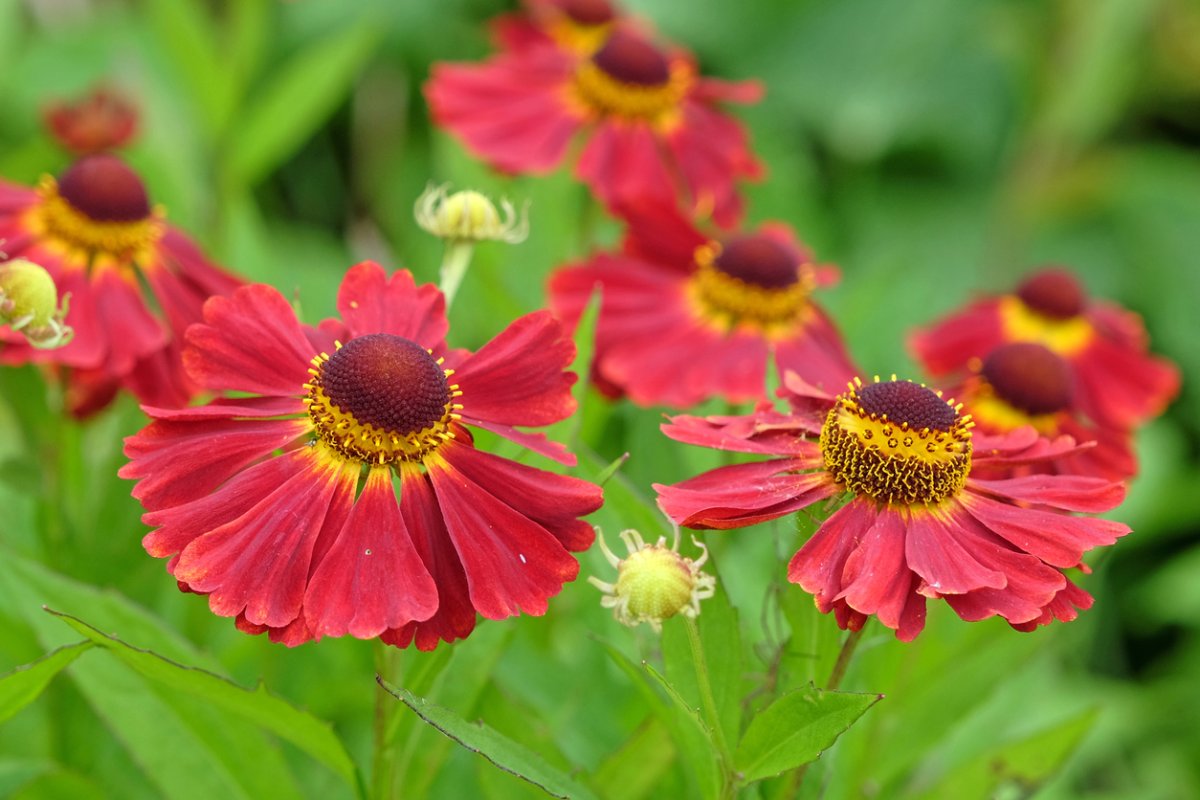

We may earn revenue from the products available on this page and participate in affiliate programs. Learn More ›
As summer wanes, so do the blooms on our favorite flowers, leaving us grasping for the last vestiges of natural color before winter takes hold. Those who hope to keep colors bright in their autumn yard can take heart: There are dozens of plants that can provide vibrant color and visual interest in your autumn landscape, even as cooler fall days give way to winter.
1. Oakleaf Hydrangea (Hydrangea quercifolia)
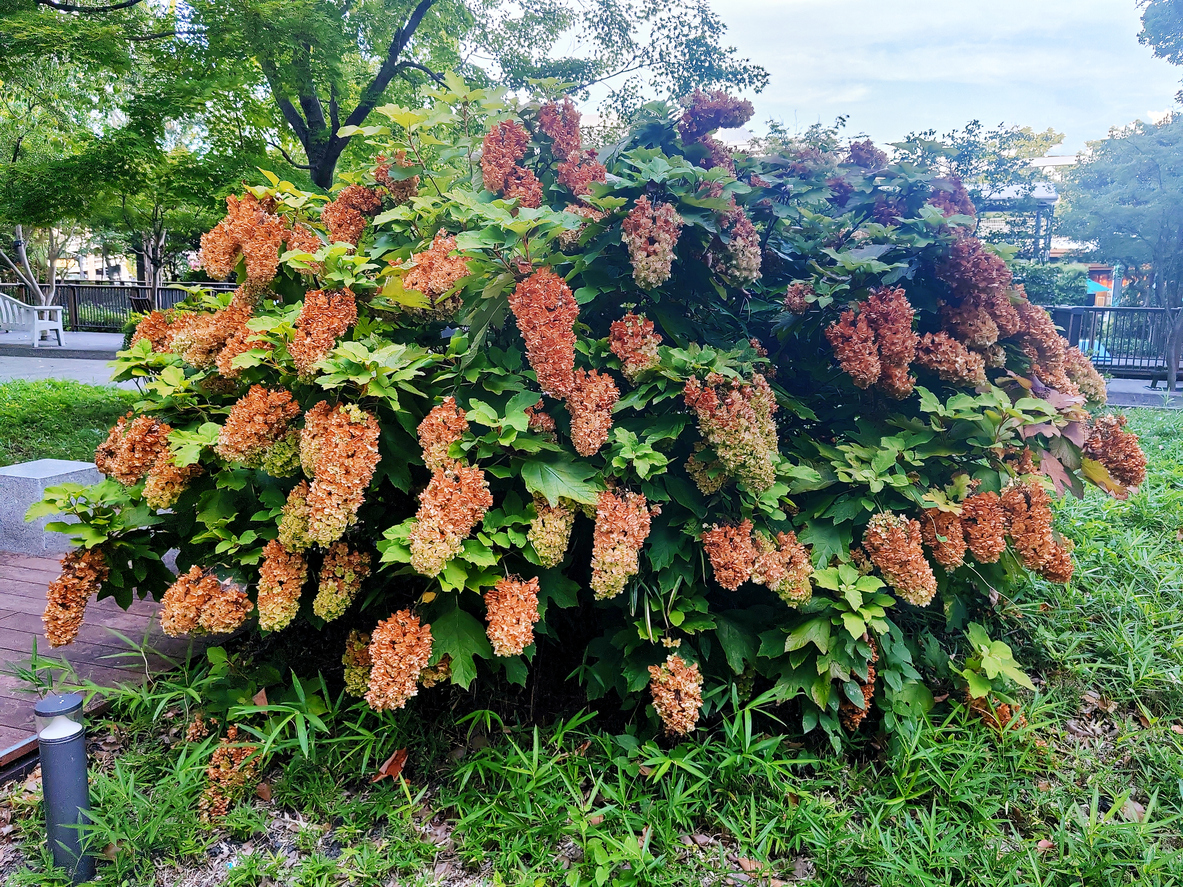
Oakleaf hydrangea gets its name from its lobed leaves, which resemble those of an oak tree. Also like the oak tree, this deciduous, woody shrub’s leaves turn brilliant shades of red and orange as winter approaches. The showy white bloom clusters of this hydrangea emerge in early summer and change color as summer progresses into fall, adding another layer of brilliant beauty to the fall garden.
RELATED: How to Dry Hydrangeas for Stunning Tabletop Displays
2. Ornamental Pepper (Capsicum annuum)

You can eat the fruits of ornamental pepper plants even though they’re not as flavorful as varieties grown for cooking, but leave them alone and they’ll throw a party in your landscape come fall. The colorful little fruits come in shades of red, orange, purple, yellow, and white, with some varieties boasting multiple colors on the same plant! Though ornamental peppers are typically grown as annuals, gardeners in Zone 9b and above can grow them as perennials. They can also be grown indoors.
RELATED: The 25 Best Types of Peppers for Novice Gardeners to Grow
3. Anise Hyssop (Agastache foeniculum)

Pollinators love anise hyssop for its 2- to 4-foot spikes of purple flowers that bloom well into fall. Native to the American Midwest, these short-lived, low-maintenance perennials will thrive in just about any soil condition. All parts of anise hyssop are edible; the leaves can be made into tea, and other parts of the plant are thought to have medicinal value.
RELATED: 15 Perennial Herbs to Grow for Years of Fresh Flavor, Pest Control, and Cleaning Supplies
4. Coral Bells (Heuchera spp.)

Shade-loving coral bells send up delicate stalks of flowers in spring and summer, but their colorful foliage lasts through fall and beyond. These North American perennial natives are hardy in USDA zones 4a to 9a. Coral bells prefer rich, moist, well-drained soil and do better if they’re shaded for a good part of the day. They’ll grow as tall as 3 feet and as wide as 2 feet.
RELATED: 25 Easy-Care Plants That Survive With or Without You
5. Strawflowers (Xerochrysum bracteatum)

The papery blooms on strawflowers make them a favorite with crafters who want to add a playful touch to potpourris or wreaths, and gardeners will find them easy to grow in sunny beds. When cared for properly, these fast-growing, short-lived perennials will return for 3 or 4 years. Plant them in full or partial shade in sandy or rocky soil that’s neutral or mildly acidic. They’re somewhat drought-tolerant, but can’t go more than about a week without a shower.
RELATED: 10 Fall Flowers That Are Hardy in Cold Weather
6. Leadplant (Amorpha canescens)
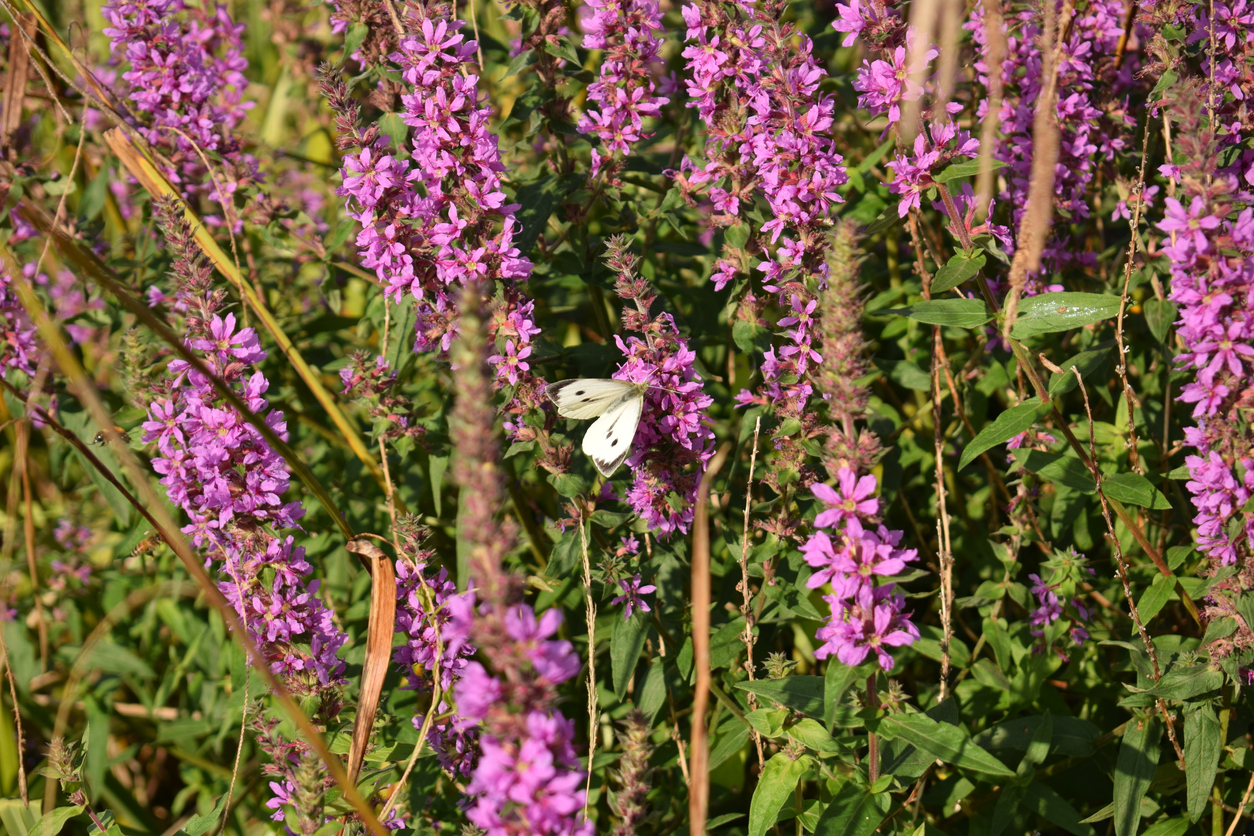
Used as a low ground cover, leadplant blossoms during the fall with a beautiful blue color that turns vivid red later in the season. Add it to a container or bed for a jolt of color.
RELATED: The Best Low-Maintenance Ground Cover Plants for Your Property
7. Snapdragon (Antirrhinum majus)
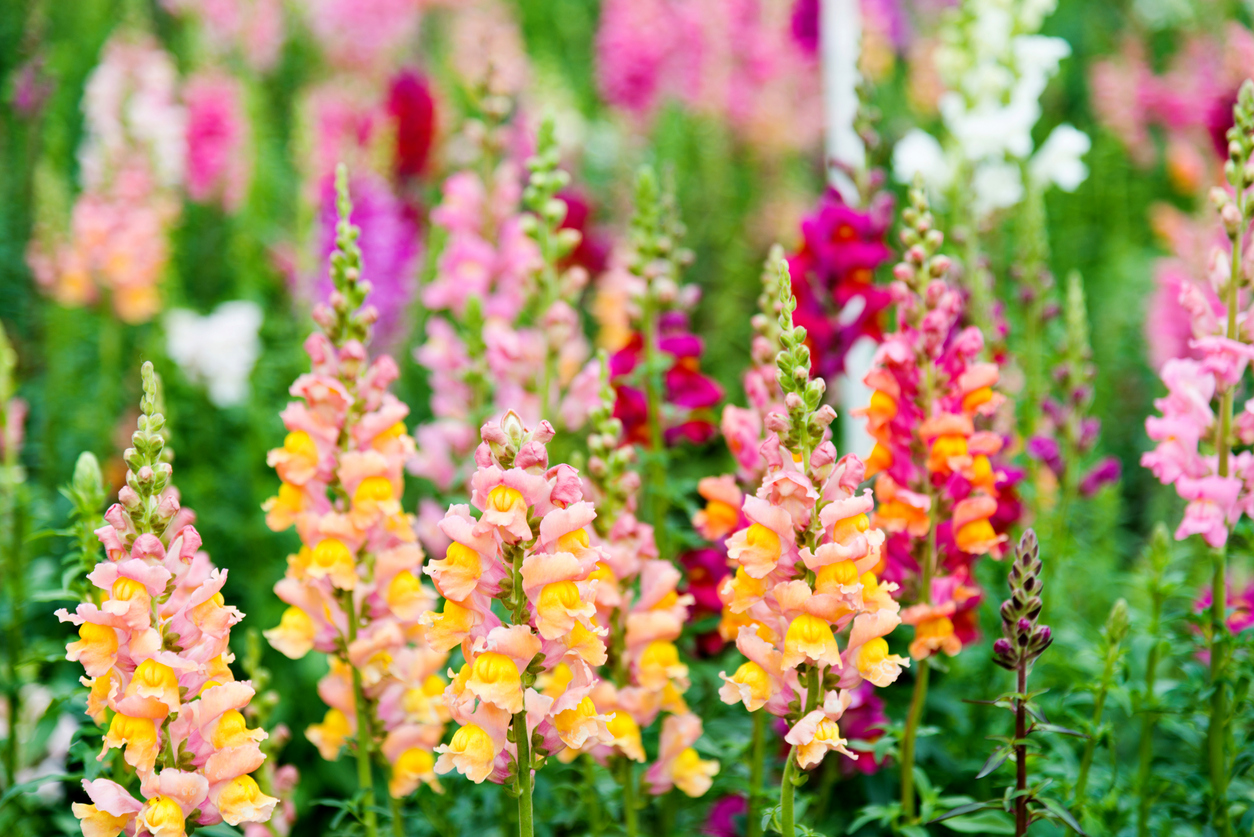
Snapdragons’ tall columns of spectacular flowers emerge in spring in any of a wide variety of colors, including orange, pink, purple, and yellow. Snapdragons are loved for their cold-hardiness, and while they generally take a break from blooming during the height of summer, they’ll start up again as the hot season eases into autumn. Plant them in sun or part sun in moist, well-draining soil.
RELATED: 23 Annual Flowers That Add a Pop of Personality to Any Home Landscape
8. American Beautyberry (Callicarpa americana)
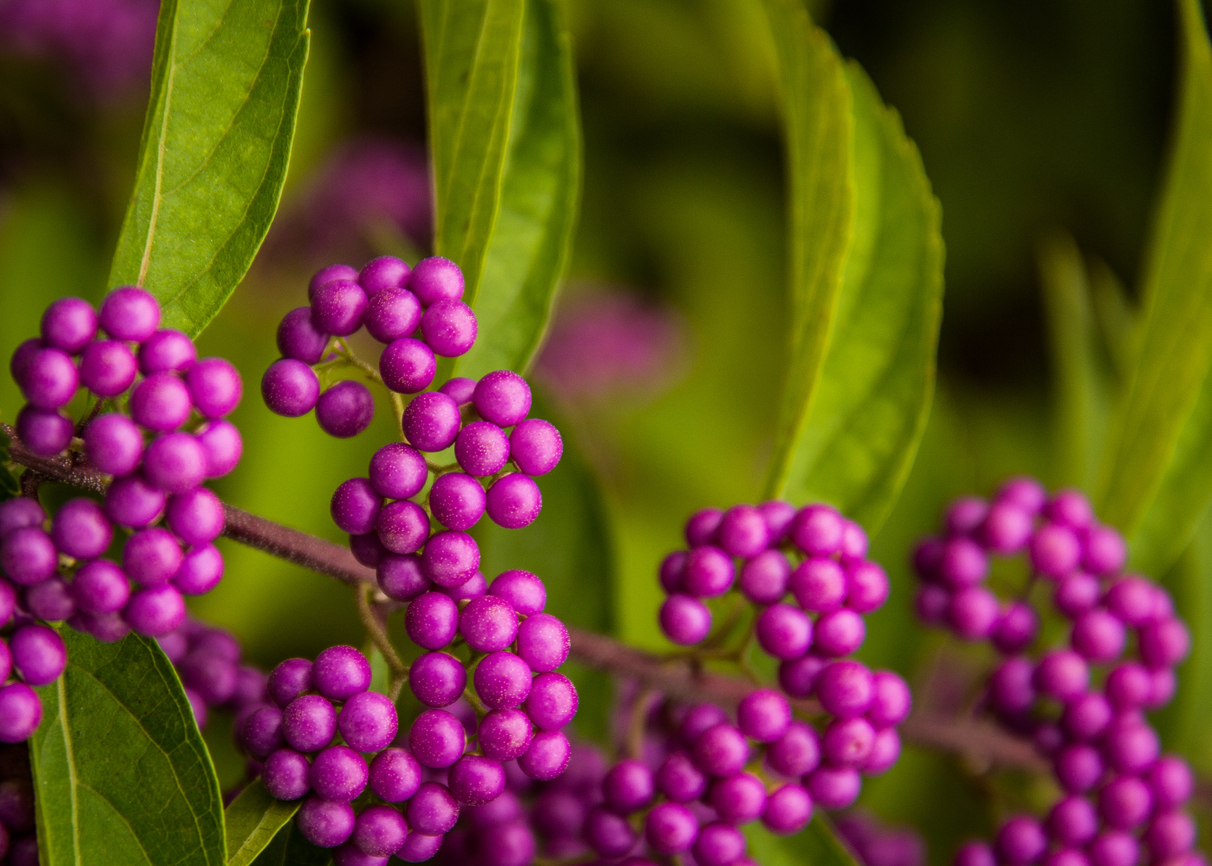
Clusters of tiny, glossy purple berries make American beautyberry an autumn showstopper. In spring months, the shrub attracts pollinators like bees and butterflies with its flowers, and in fall its fruit adds color to the yard. The berries adorn the plant’s draping branches well after the leaves have fallen and will attract small wildlife to your garden as the weather chills. Requiring very little care, this low-maintenance shrub is the perfect choice for lazy gardeners.
RELATED: 18 Fast-Growing Shrubs to Plant This Fall
9. Mexican Feathergrass (Nassella tenuissima)
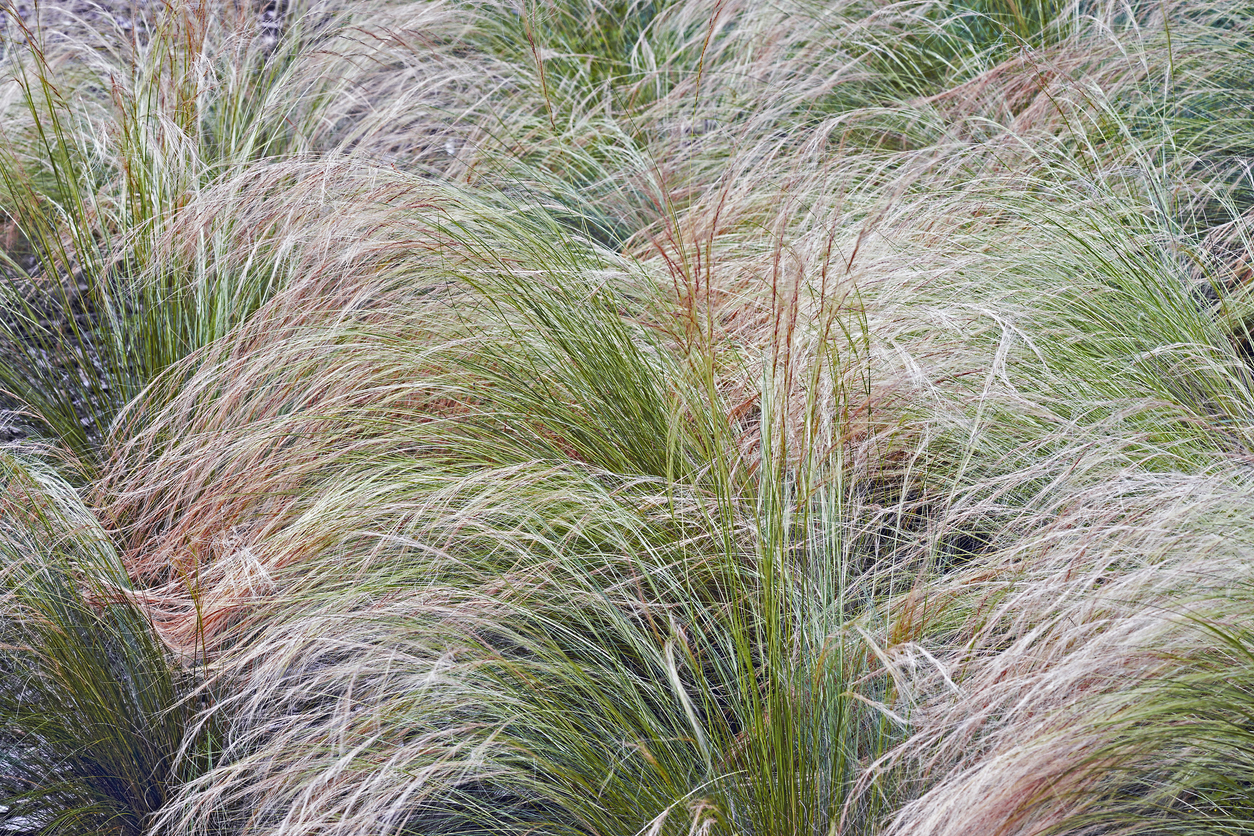
The reddish feathery stalks of Mexican feathergrass turn an amber color in the fall, making them an excellent choice for high-impact gardens. These hardy deciduous or evergreen plants are extremely drought-tolerant and do well in full sun or part shade. Preferring neutral, loamy soil, Mexican feathergrass grows to 2 feet tall and wide.
RELATED: The 22 Best Ornamental Grasses for Adding Drama to Your Property
10. Japanese Maple (Acer palmatum)
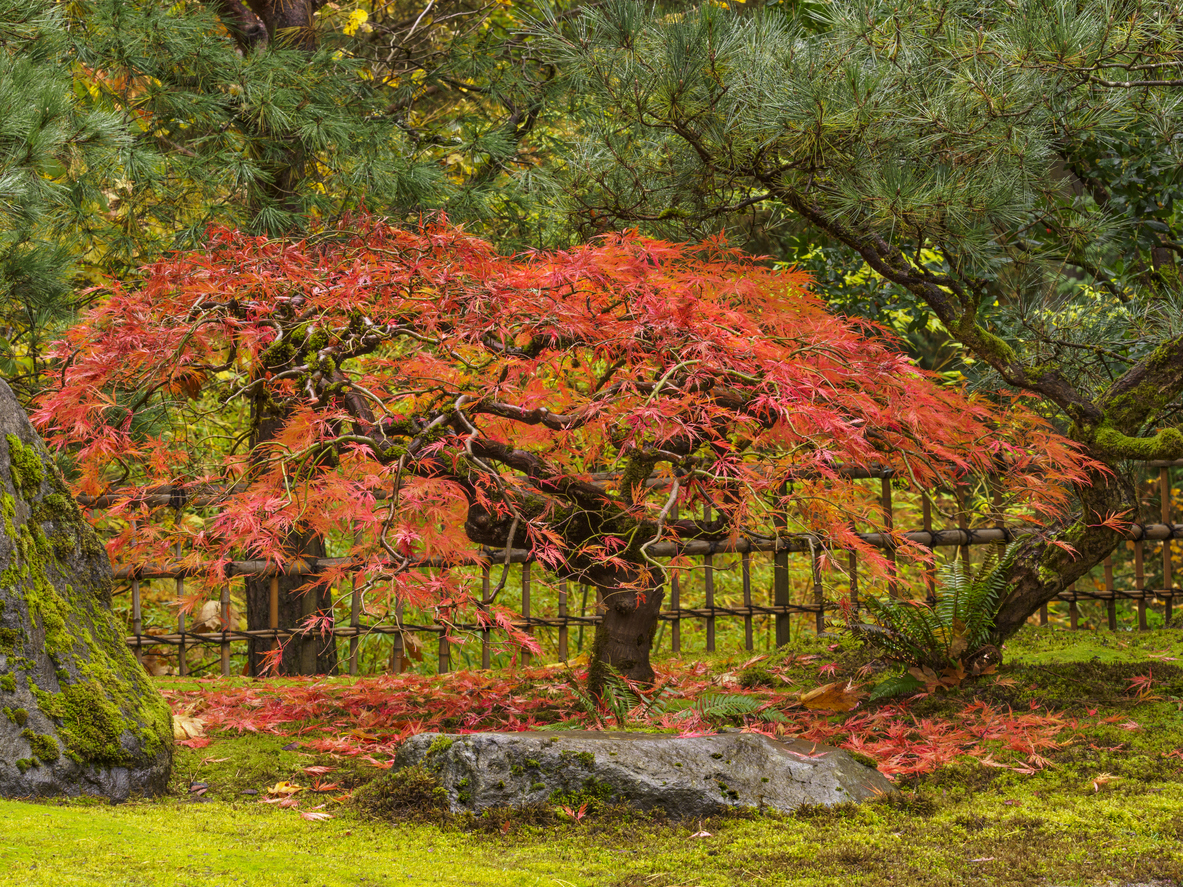
Japanese maple is a breathtaking accent tree popular for its feathery leaves and graceful, weeping silhouette. In fall, the maple’s leaves turn crimson, orange, or gold, with some varieties successively displaying all three colors. Gardeners in zones 5 through 8 have the best luck getting colorful leaves; colors aren’t as vibrant in hotter areas.
RELATED: The 20 Best Dwarf Trees for the Front Yard
11. American Witch Hazel (Hamamelis virginiana)
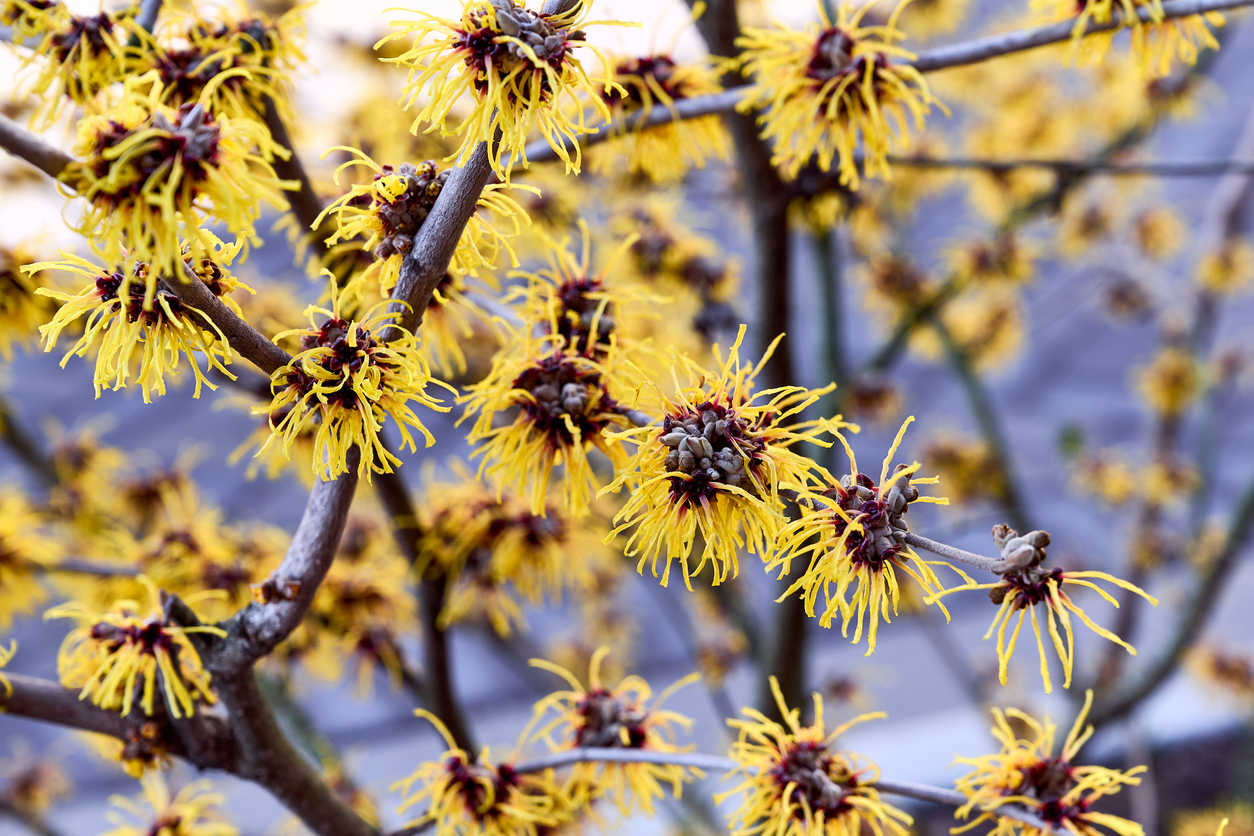
American witch hazel is a large, deciduous shrub whose showy and fragrant flowers bloom in fall. Its yellow, feathery blooms linger until December, when all the beautiful autumn leaves have fallen, making it a welcome sight at a time when most other landscape plantings have lost their color. Plant witch hazel in moist, well-drained soil in a place where it will get at least 6 hours of full sun.
12. Ornamental Kale (Brassica oleracea—Acephala Group) and Cabbage (Brassica oleracea—Capitata Group)

Ornamental kale and cabbage are cultivated for looks, not taste. Their low habit and brilliant colors (think purple, pink, and cream) make them an optimal choice for cool-weather edging and ground cover. Though their flavor will not appeal to humans, they make a tasty treat for animals, so be careful where you plant them, especially if your neighborhood is home to deer. These kale and cabbage plants don’t tolerate hot weather, so be sure temperatures have cooled before planting.
RELATED: 15 Things to Plant Now for Your Fall Vegetable Garden
13. Winterthur Viburnum (Viburnum nudum ‘Winterthur’)
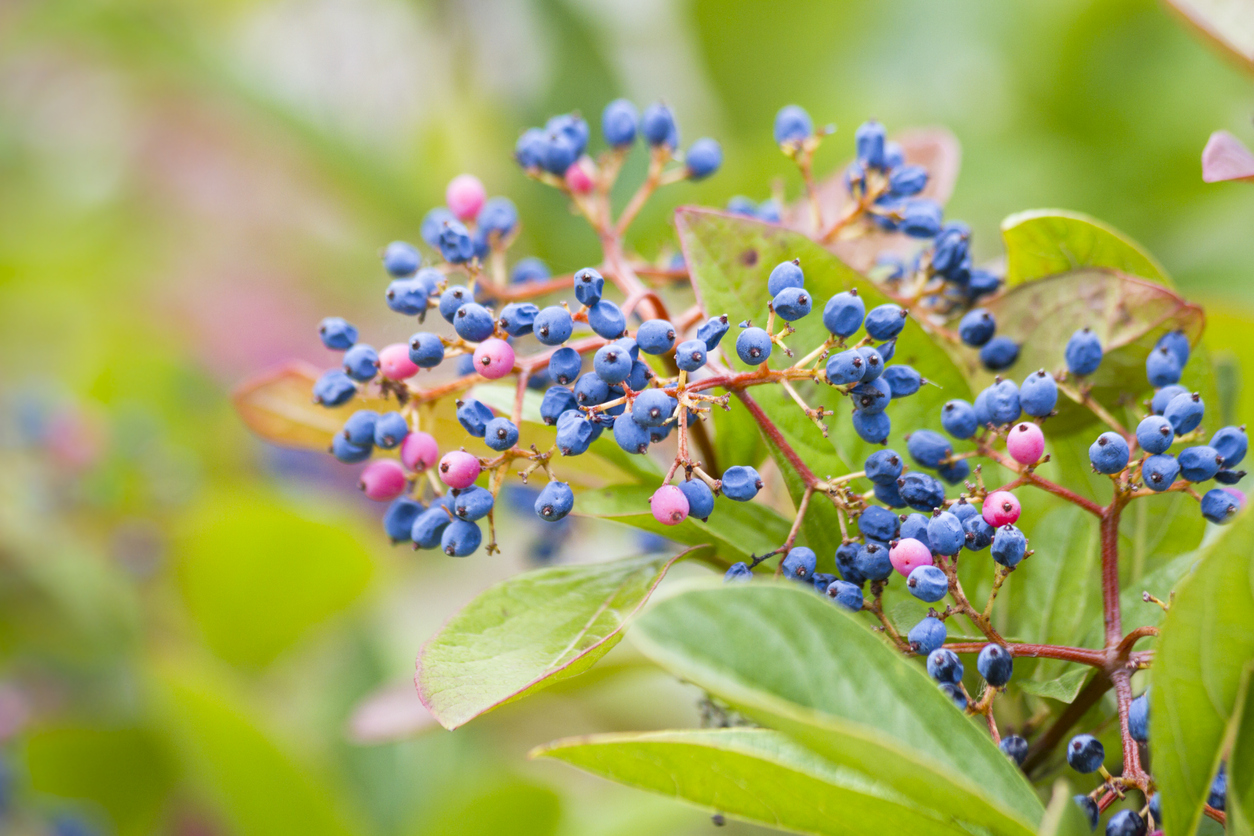
Some showy fall shrubs grace the garden with vibrant leaf color, and some with sensational berries. Winterthur viburnum offers both to gardeners in zones 5 through 9. This large shrub has crimson leaves and deep blue berries that give your landscape a double dose of autumn beauty, and will keep your yard looking lovely even when other plants die back. Native to the eastern and southeastern United States, viburnum prefers wet soil and full sun or part shade.
RELATED: 20 Plants That Thrive Even When Temperatures Rise
14. Firethorn (Pyracantha)

Firethorn is an evergreen shrub that provides all-season interest in the yard. The small white flowers that appear in summer give way to orange or red berries that remain through winter, providing food for birds as well as a beautiful view from your window. Firethorn will do well in dry soil but will grow larger—up to 16 feet tall and wide—in damper areas. Give some thought to where you plant it, because its branches are thorny.
RELATED: Boost Your Home Security by Adding These Thorny Plants to Your Landscape
15. Pansy (Viola tricolor var. hortensis)
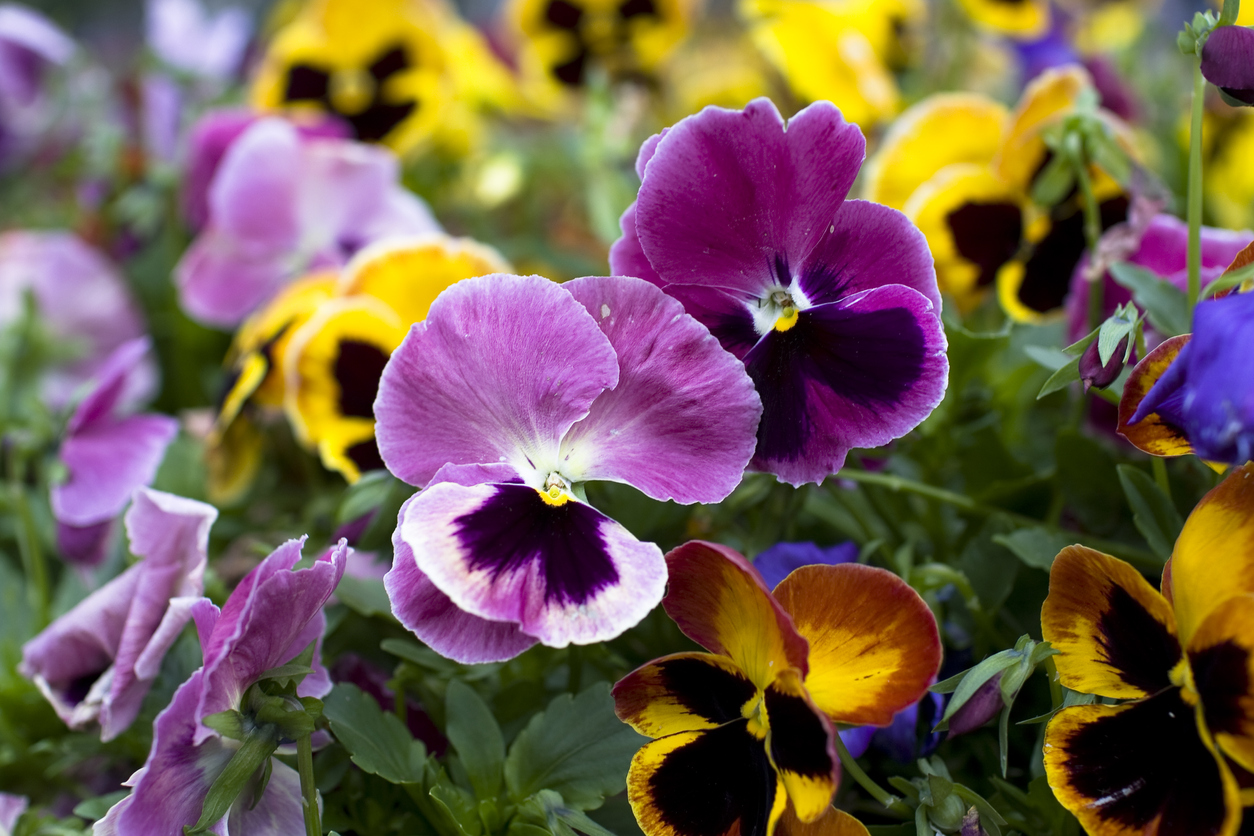
Hardier than they look, pansies are a graceful cold-season annual that can withstand the variable temperatures of fall in many zones. Available in combinations of white, purple, yellow, pink, and more, there’s a color for every garden’s palette. Thriving in rich, well-drained soil, pansies grow in compact mounds about 12 inches tall and wide. Plant them in an area that gets about 6 hours of sun daily.
RELATED: The 25 Best Plants for Hanging Baskets
16. Chrysanthemum (Chrysanthemum)
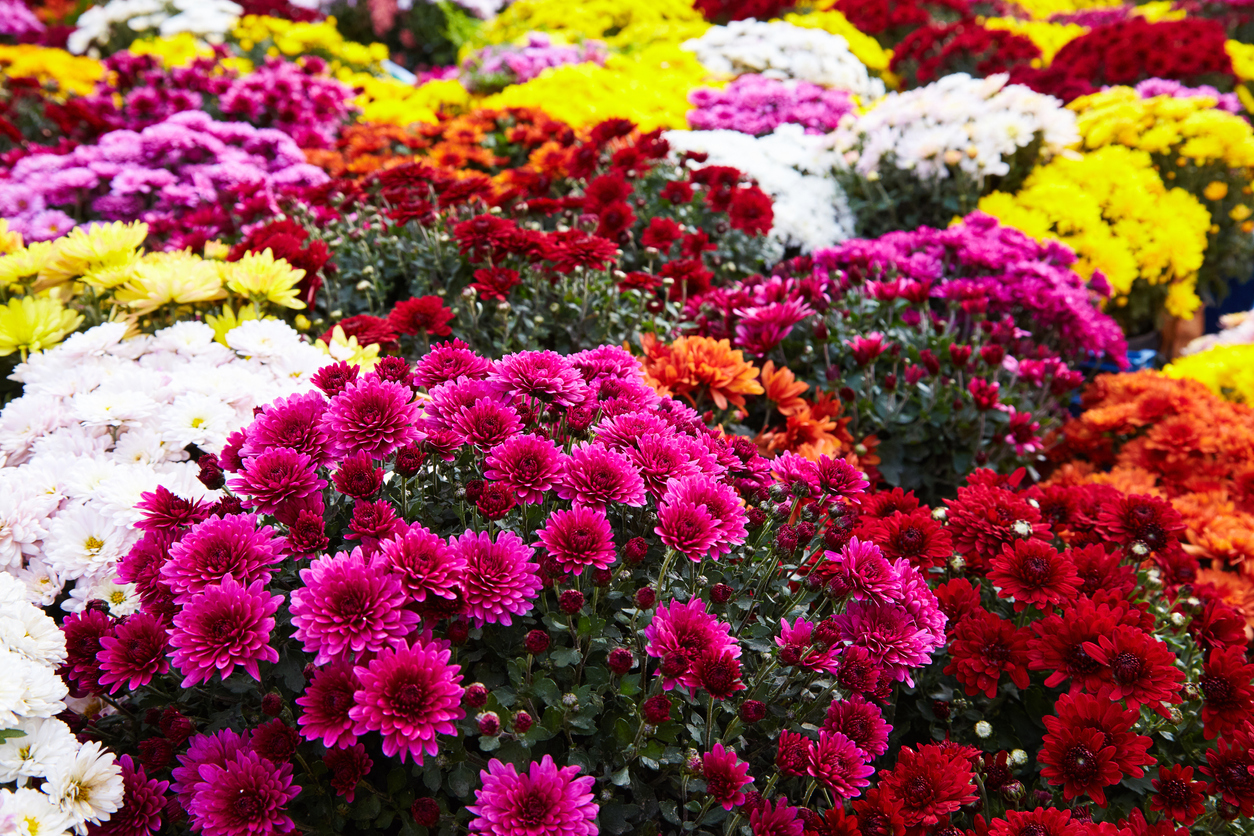
Chrysanthemums are a staple of fall decorating schemes and can be purchased anywhere plants are sold, starting in late August. Many people treat mums as annuals, displaying them in container gardens to add color to a fall porch. They can, however, also be grown as perennials when planted directly in a flower bed. Remove perennial varieties from their pots and plant them before the ground freezes, and you’ll have a good chance they’ll return next year.
RELATED: 10 Fall Flowers That Are Hardy in Cold Weather
17. Helenium (Helenium autumnale)
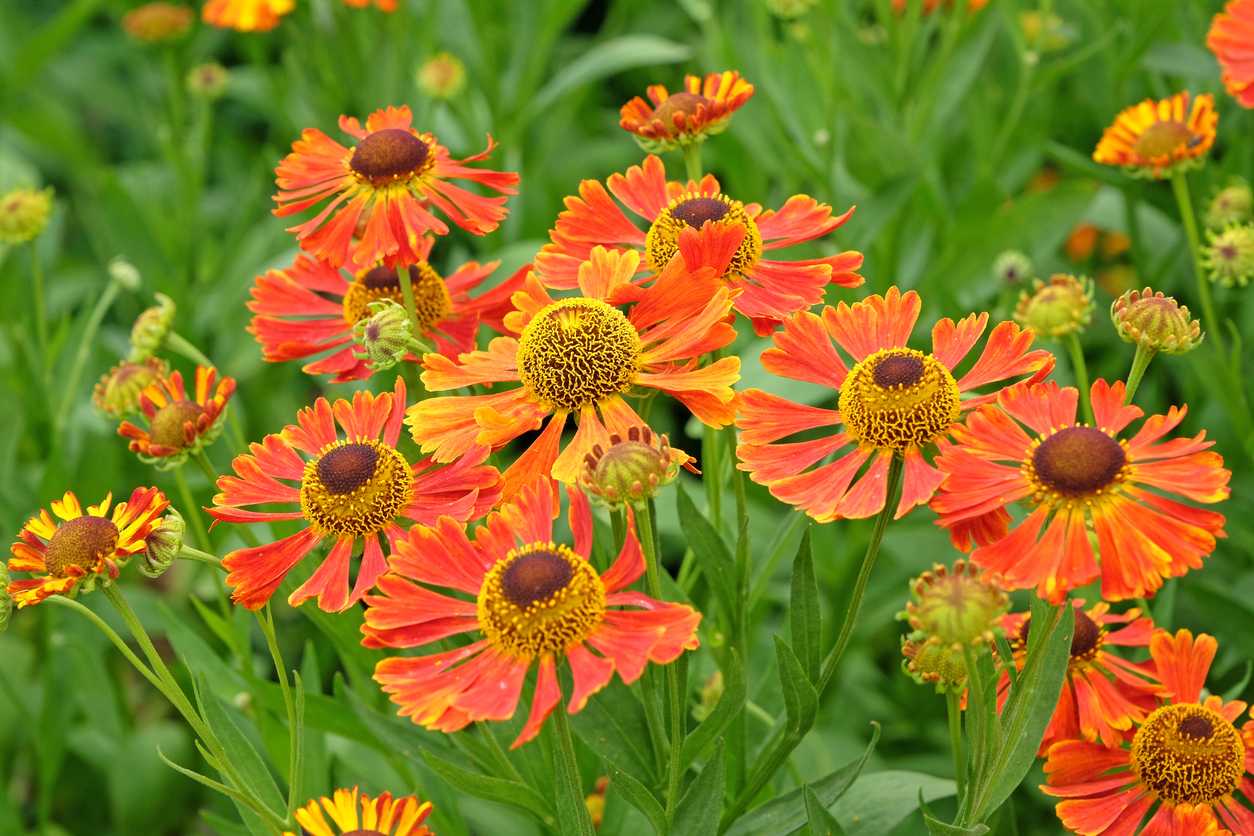
A member of the sunflower family, helenium is an herbaceous perennial that lights up with dense clusters of orangey-red flowers in fall. Also known as sneezeweed, helenium sports long-lasting blooms that add color to the garden, or to centerpieces as cut flowers. This plant does well in zones 3 through 8 and prefers moist, well-draining soil. Low maintenance and deer-resistant, these autumn companions will add cheer to your garden year after year.
RELATED: 17 Deer-Resistant Plants, Flowers, and Shrubs
18. ‘Autumn Joy’ Sedum (Hylotelephium telephium ‘Herbstfreude’—‘Autumn Joy’)
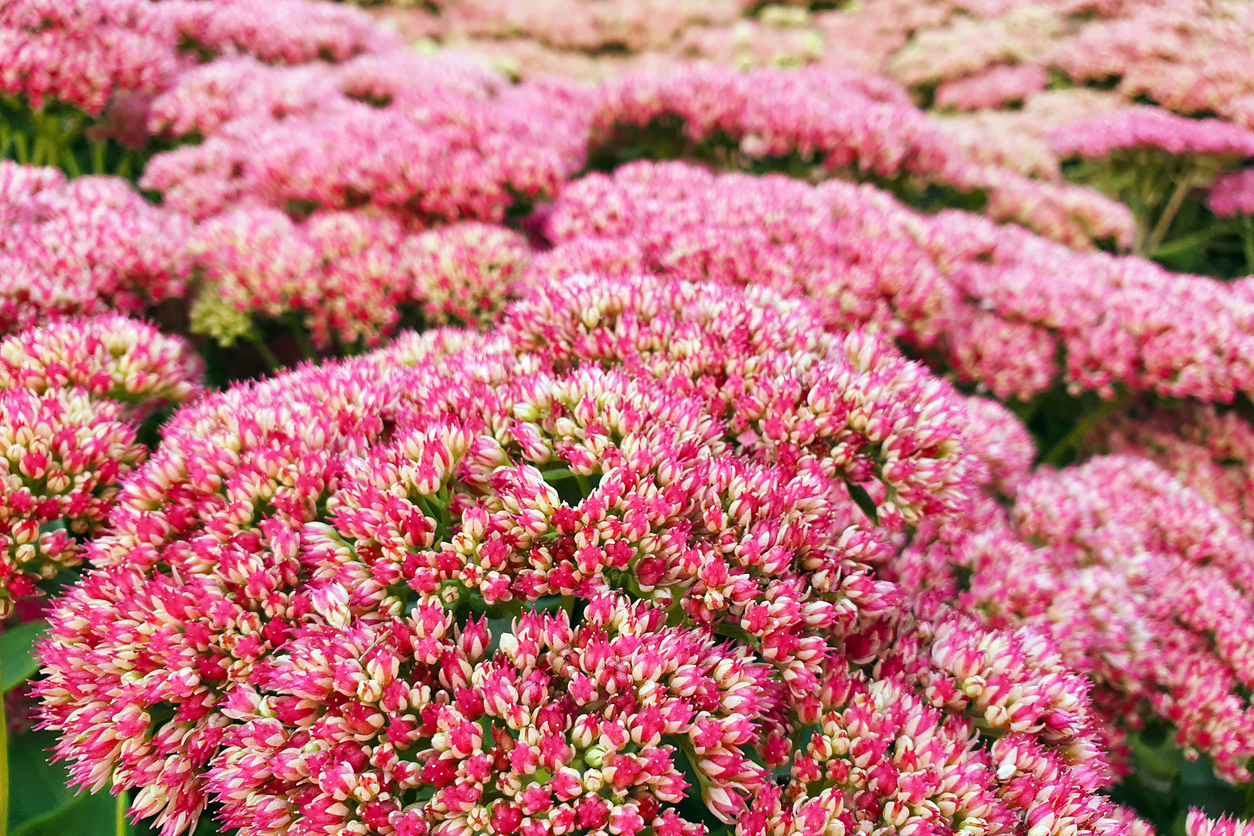
One of the many varieties of stonecrop, ‘Autumn Joy’ sedum offers a bounty of dark pink blooms from August through November. Those flowers turn copper as the weather gets colder and, when cut, make a nice addition to autumn arrangements. Plant this sedum in sandy, well-drained soil; it does well in zones 3 through 9.
RELATED: The 15 Best Flowers for Rookie Gardeners
19. Toad Lily (Tricyrtis hirta)
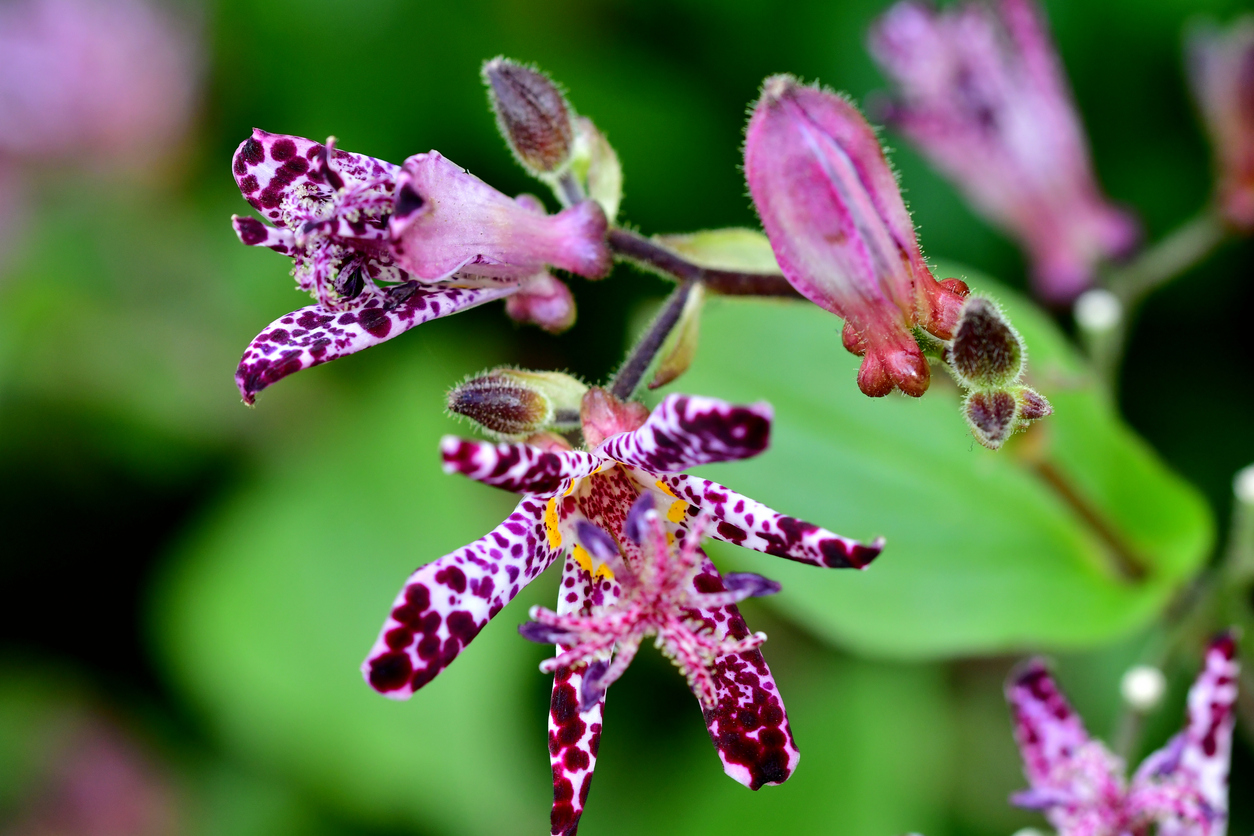
In late summer, when most perennials have finished flowering, toad lily is just getting ready to show off its orchid-like spotted blooms. These shade-loving, easy-care plants not only bring joy to the garden starting in mid-September, but also make exotic-looking flower arrangements when cut and brought indoors. Gardeners in zones 4 through 8 will find toad lilies do well for them. If you have curious cats avoid these plants, which are toxic to felines. Plant toad lily in moist, loamy soil that drains well.
RELATED: 20 Totally Free Ways to Start a Garden This Year
20. Aster (Aster)
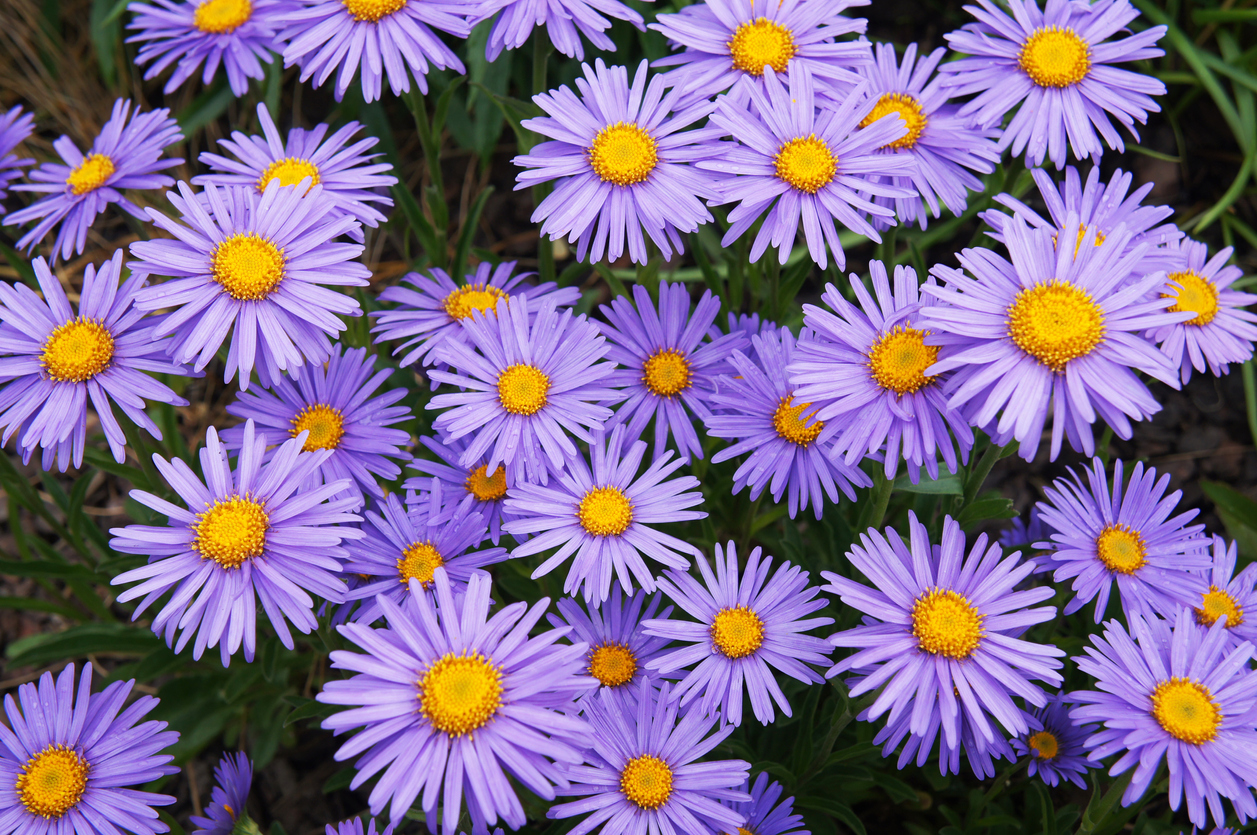
With daisy-like flowers that bloom in late summer and fall, aster brings a shock of color to your garden as other bloomers fade. With a palette consisting of pink, purple, red, and white, these cheery perennials inject a jolt of joy when you need it most. As a bonus, aster will attract butterflies to your yard. Plant these beauties in a sunny spot and keep the soil consistently moist but not saturated.
RELATED: 12 Rabbit-Resistant Plants for Your Home Landscape
21. Sweet Autumn Clematis (Clematis terniflora)

The sweet autumn clematis vine blooms in late summer to fall with masses of billowy, fragrant white flowers against dark green, leathery leaves. Tolerating full sun and part shade, it will quickly grow to cover a trellis or fence, making it a beautiful accent in an autumn yard. This one is toxic to people and pets, so keep that mind as you consider adding it to your garden. It prefers moist soil.
RELATED: 10 Climbing Plants That Are Easy to Keep Under Control
22. Virginia Sweetspire (Itea virginica)
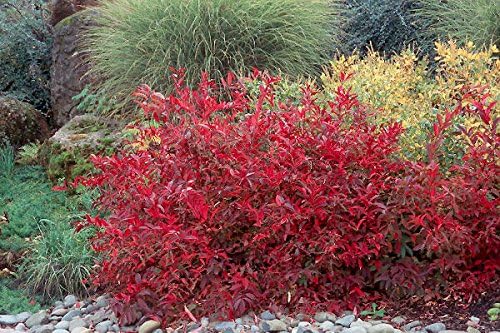
Virginia sweetspire overflows with long white blossoms in springtime, but the real show begins in fall, when its leaves turn a deep burgundy that lasts well into the season. A deciduous shrub growing to 8 feet tall, Virginia sweetspire makes an excellent woodland border plant and is drought-tolerant once established, though it does prefer moist soil.
RELATED: 20 Plants to Use as Lawn and Garden Borders
23. Burning Bush (Euonymus alatus)
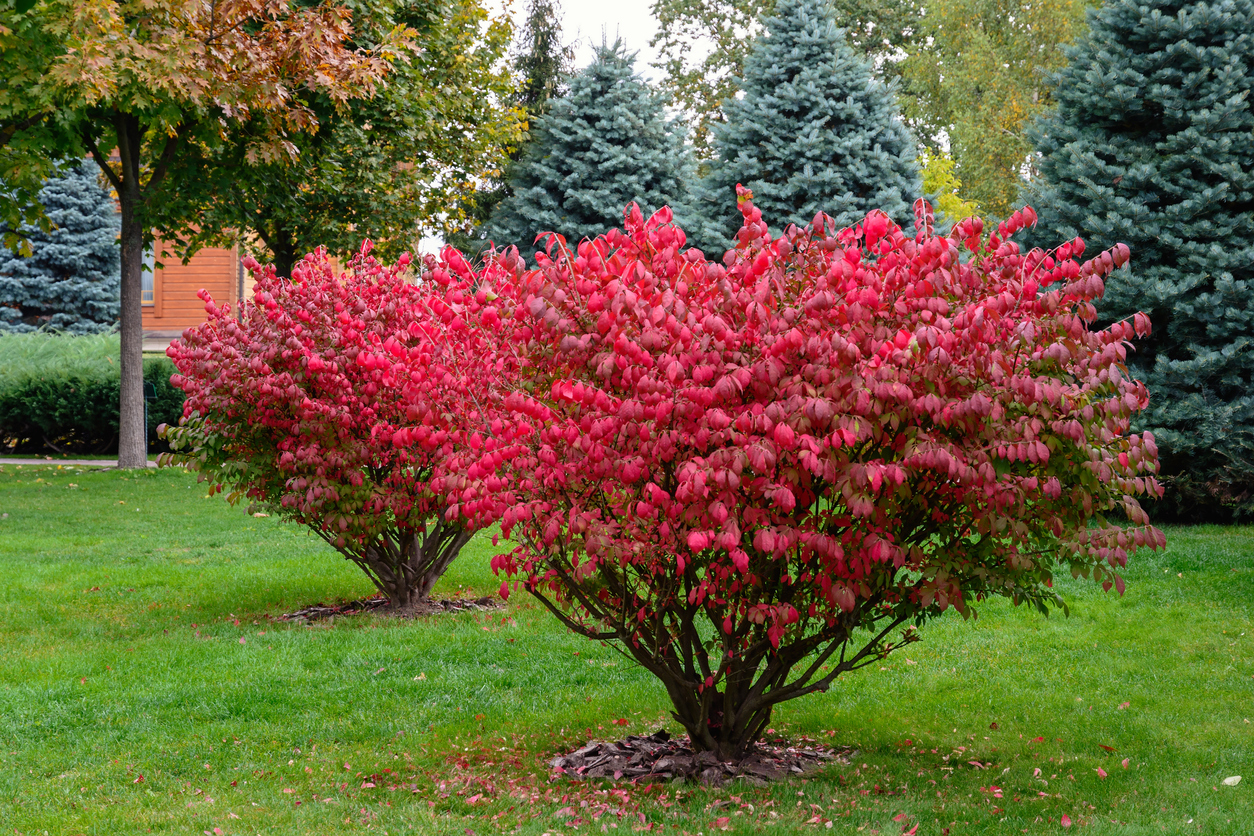
Plant a burning bush and you will be treated to a profusion of crimson foliage in fall. A member of the euonymus family, this easy-to-grow shrub tolerates most soil types, so long as they are moist, and flourishes in both full and partial sun. It’s suited to zones 4 through 8 and can get as big as 20 feet tall and 12 feet wide.
Burning bush is not suitable for every property. It can spread aggressively and is toxic—take these things into consideration when planning your landscape.
RELATED: 14 of the Most Dangerous Plants in America
24. Chinese Lantern (Physalis alkekengi)
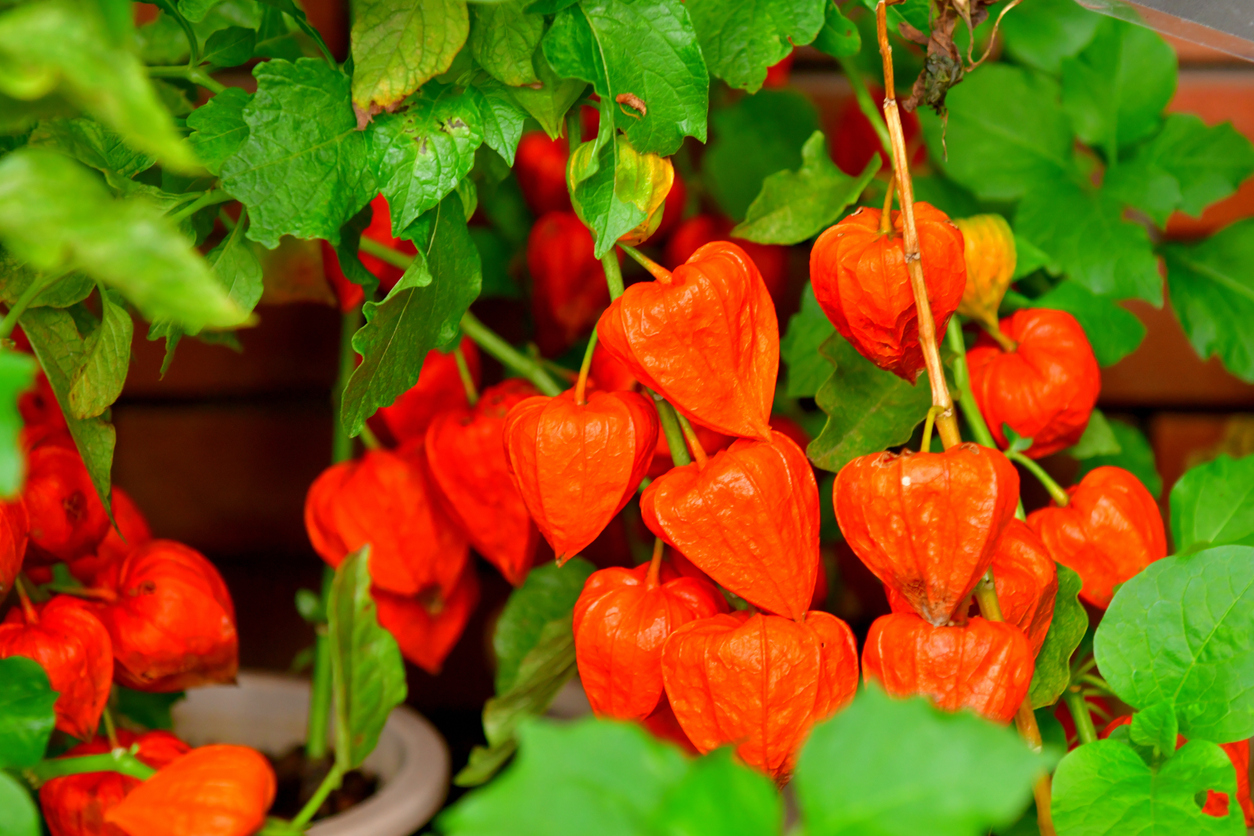
The Chinese lantern plant produces delicate white flowers, but that’s not what makes it spectacular in autumn. As the flowers grow, in full or part sun, they develop a papery seed pod that turns bright orange. The pop of color looks cheery in the garden, but stems can also be dried and brought indoors for festive arrangements. This plant likes moist, well-draining soil with a neutral pH.
RELATED: Beyond Poinsettias: 23 Houseplants That Bloom in Winter
25. Lamb’s Ear (Stachys byzantina)
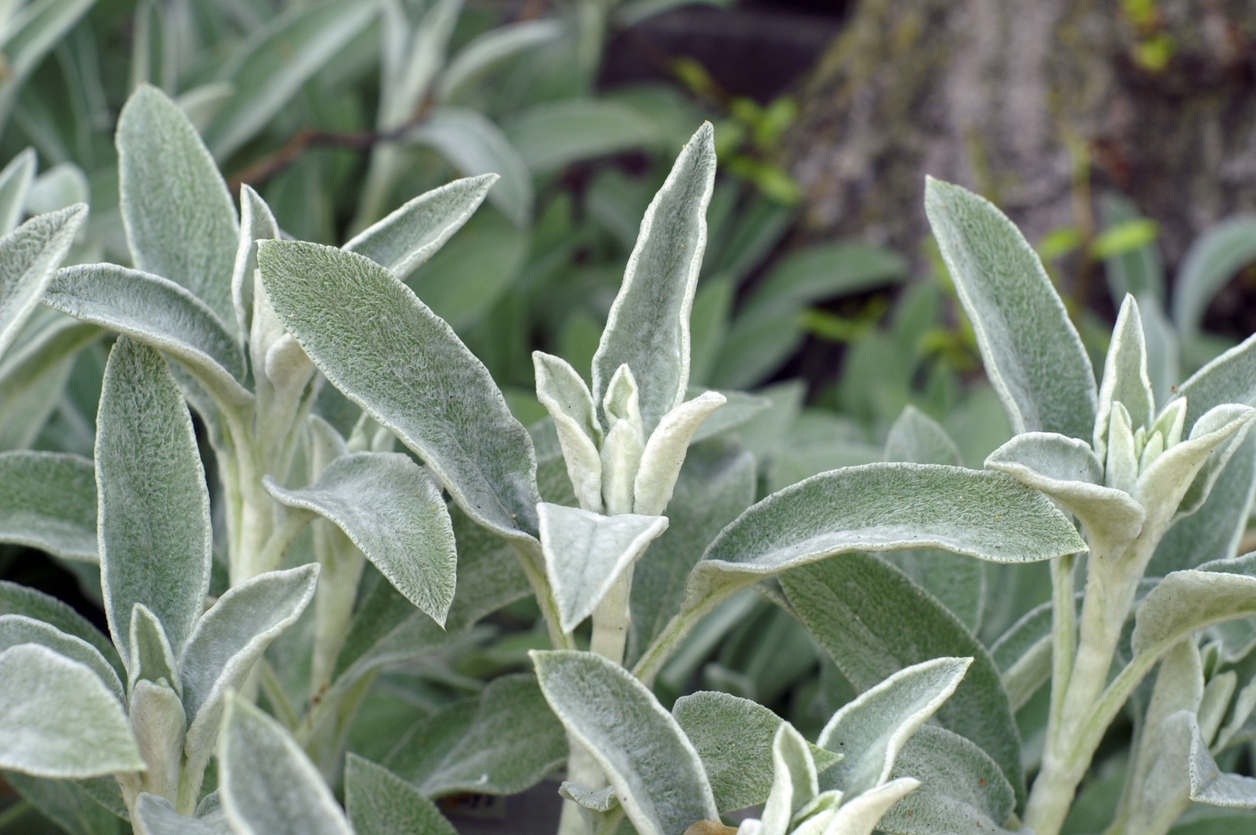
The soft, silvery-green leaves of lamb’s ear persist even as other landscaping plants die back at the end of summer. A fast-spreading ground cover, lamb’s ear does best in full sun and can be divided into new plants every few years in spring. This plant prefers slightly acidic soil and does well in zones 4 through 9. Not picky about soil quality, lamb’s ear is a nice addition to rock gardens.
RELATED: The 15 Best Plants for Rock Gardens
26. Arkansas Blue Star (Amsonia hubrichtii)
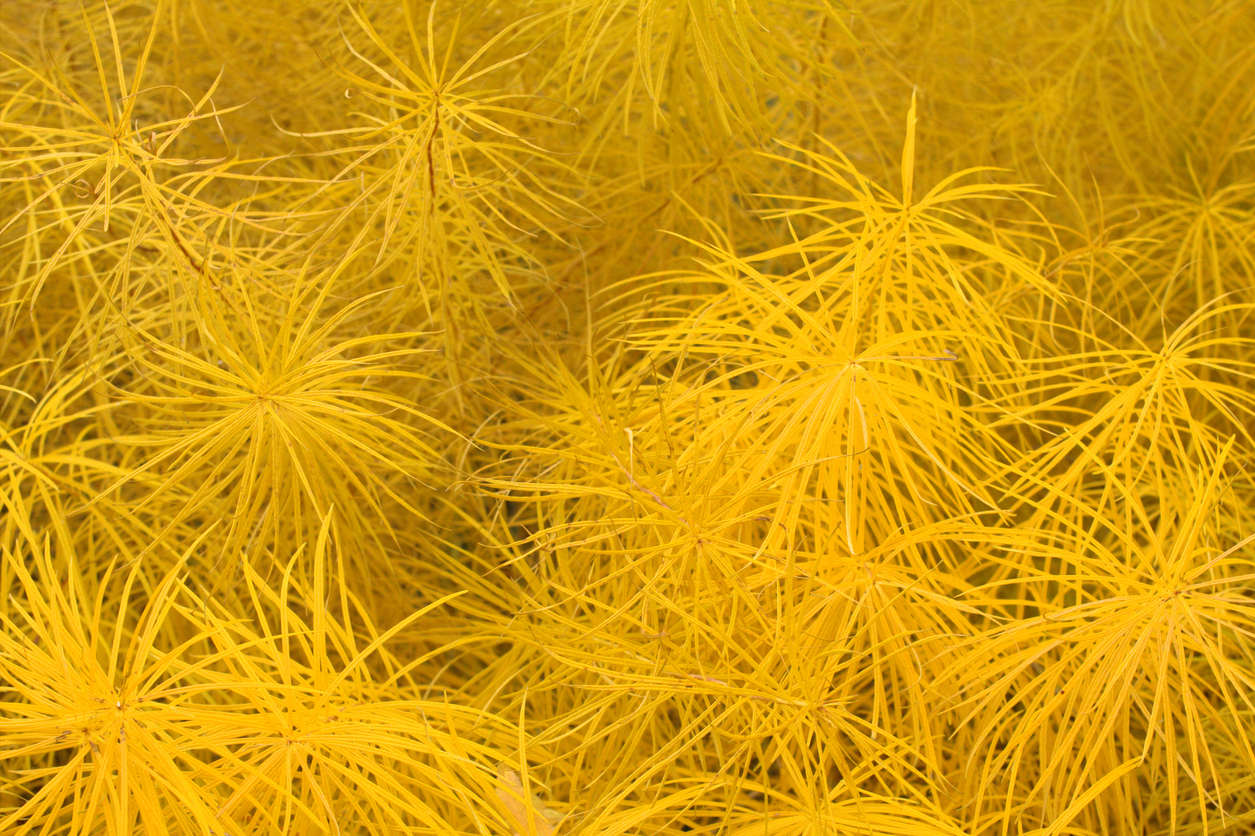
Arkansas blue star is cultivated for its feathery green foliage and soft blue, star-shaped flowers that bloom in spring, attracting butterflies. This perennial puts on a second show in fall, when its needle-like leaves turn a brilliant gold. The leaves remain through a portion of the winter months, adding all-season interest to your yard. The plant grows in bushy clumps until it is about 3 feet tall and wide; it prefers well-drained soil in sun or part shade.
RELATED: 50 Plants That Thrive in Any Yard
27. Black-Eyed Susan (Rudbeckia hirta)
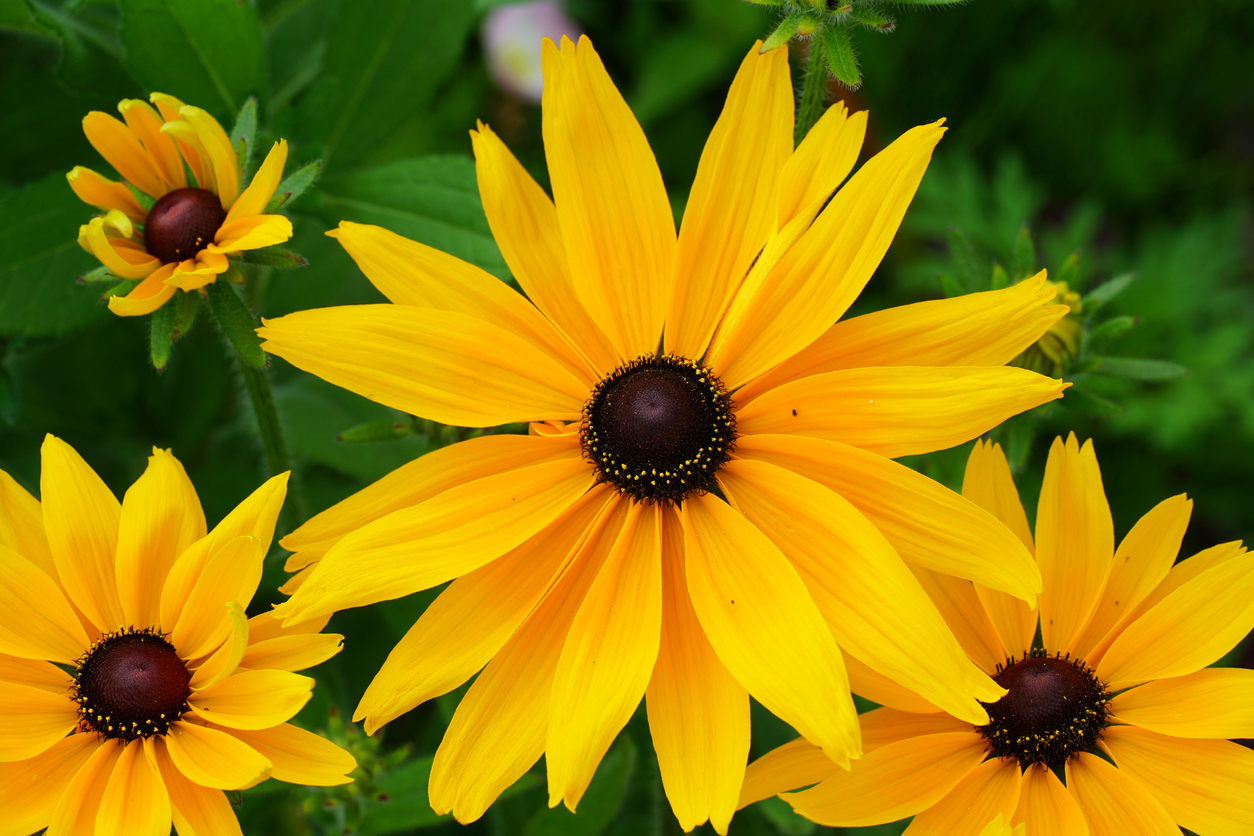
Black-eyed Susans explode with blooms in summer, but gardeners who deadhead their plants will be rewarded with a second batch of flowers in fall. This central U.S. native is hardy in zones 4 through 9 and prefers moist, well-drained soil and full sun. Black-eyed Susans grow to be 2 to 3 feet tall and 1 to 2 feet wide. Water them well right after planting, and as they establish, they will be drought-tolerant.
RELATED: 20 Flowers That Attract Bees to Your Garden
28. River Birch (Betula nigra)
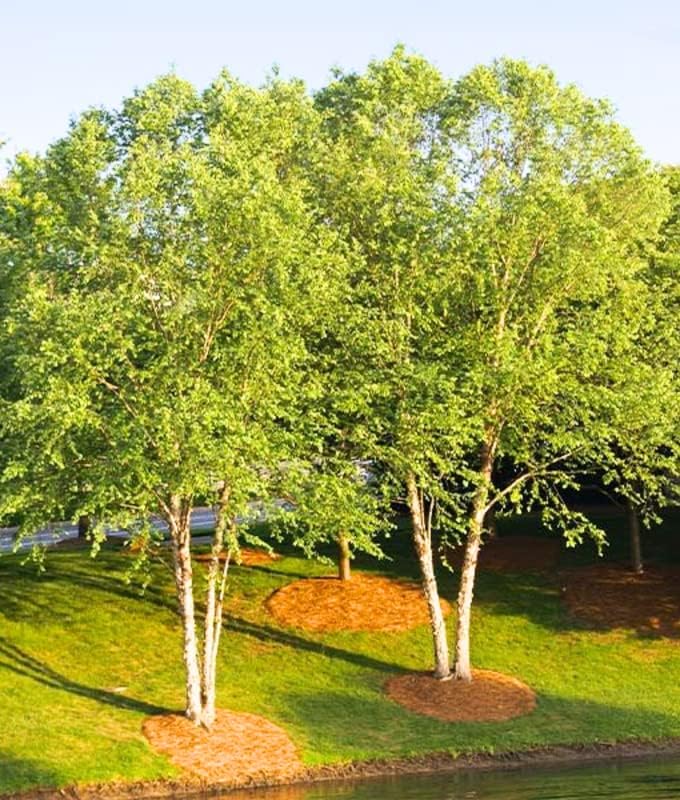
The fast-growing river birch tree lights up the yard in fall when its green leaves turn bright gold. The colorful leaves offer a dazzling contrast against its distinctive white, texture-rich bark. A deciduous tree, river birch prefers consistently moist, acidic soil and needs at least 6 hours of sun. It’s suited to zones 4 through 9.
RELATED: 22 Fast-Growing Shade Trees to Plant in Your Yard
29. Fire and Ice Hydrangea (Hydrangea paniculata ‘Fire and Ice’)
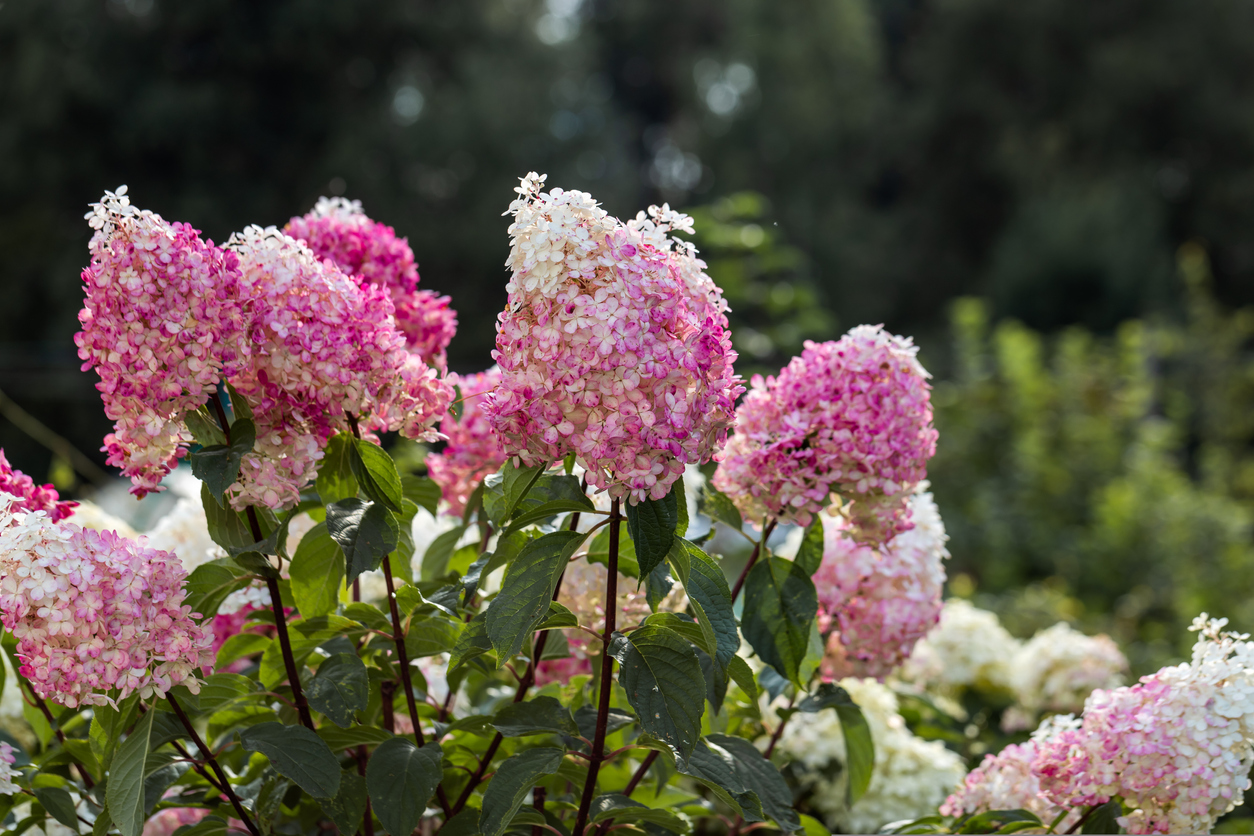
The Fire and Ice cultivar of Hydrangea paniculata blooms from spring through fall, changing color as the seasons progress. White blossoms in spring give way to pink flowers in summer, followed by vibrant red blooms in fall. Fire and Ice hydrangea will delight in three out of four seasons, and it tolerates winter well. It needs part to full sun, but it can’t take the heat south of Zone 8.
RELATED: How to Grow Hydrangeas
30. Red Twig Dogwood (Cornus sericea)
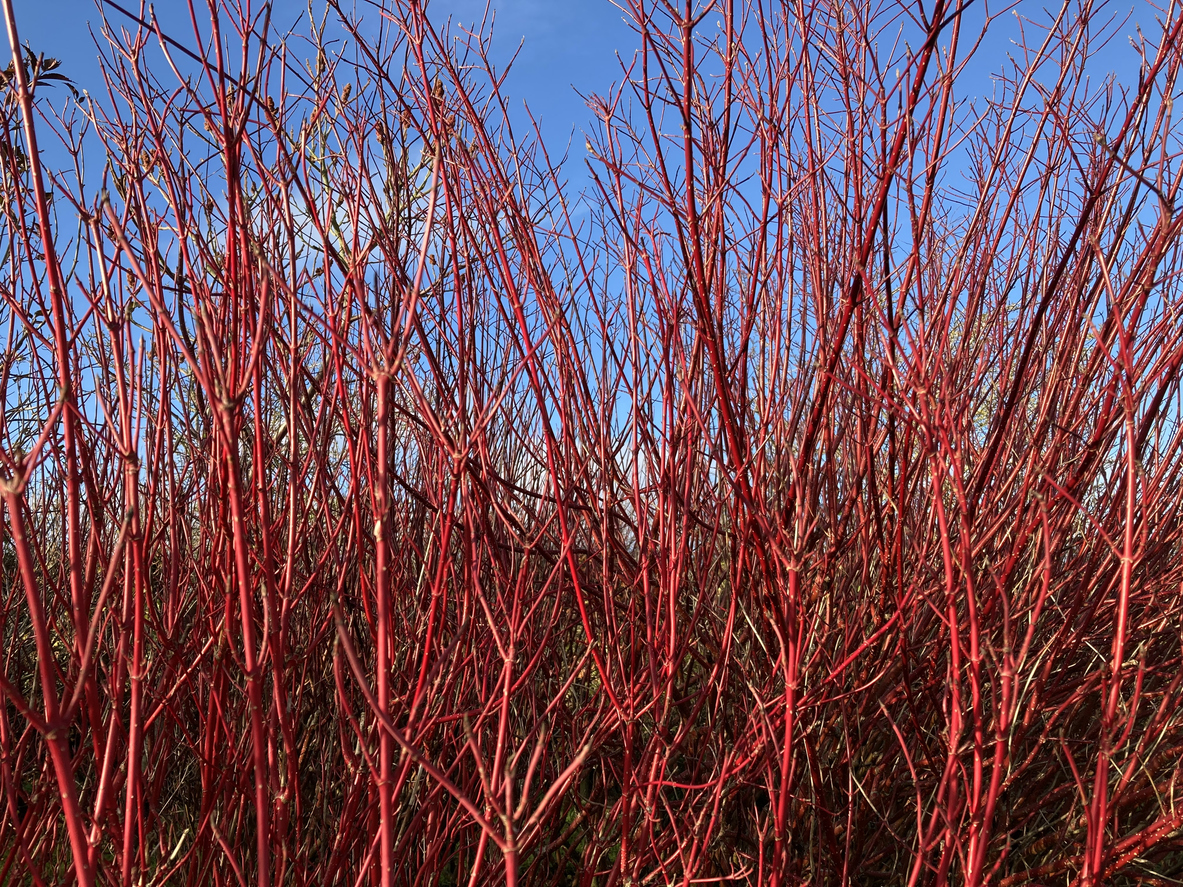
Red twig dogwood provides year-round interest, particularly in fall, when plump white berries appear on the shrub’s burgundy branches. This large shrub is a stunner, whether planted as a hedge or an accent. While the shrub, which grows 6 to 9 feet tall and 8 to 12 feet wide, can tolerate a bit of shade, you’ll see better color if it’s planted in full sun. Red twig dogwood needs moist, acidic soil.
